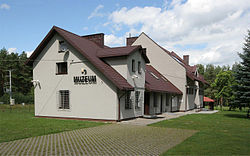Loading AI tools
Treblinka, Masovian Voivodeship
Village in Masovian Voivodeship, Poland From Wikipedia, the free encyclopedia
Village in Masovian Voivodeship, Poland From Wikipedia, the free encyclopedia
Treblinka (Polish pronunciation: [trɛˈbliŋka]) is a village located in eastern Poland, situated in the present-day district of Gmina Małkinia Górna, within Ostrów Mazowiecka County in Masovian Voivodeship, some 80 kilometres (50 miles) north-east of Warsaw. The village lies close to the Bug River. It has 350 inhabitants.
Treblinka | |
|---|---|
Village | |
 Treblinka extermination camp museum | |
| Coordinates: 52°39′30″N 22°01′15″E | |
| Country | |
| Voivodeship | |
| County | Ostrów Mazowiecka |
| Gmina | Małkinia Górna |
| Population | 330 |
It is known as the site during World War II of one of the Nazi extermination camps, named after the village. An estimated 850,000 people were murdered here during the Holocaust in Poland, from the summer of 1942 to October 1943. In addition, the Treblinka I Arbeitslager, a forced labor camp, had operated about six miles away, from June 1941 to 23 July 1944. During this period, more than 10,000 prisoners are estimated to have died from executions, malnutrition, disease and mistreatment.
Treblinka was the location of Treblinka extermination camp, where an estimated 850,000 people were systematically murdered during the Holocaust in Poland.[1] About 800,000 of them were Polish Jews.
The first deportations took place in the course of the Grossaktion Warsaw with about 254,000 Warsaw Ghetto inmates brought in to their deaths in Holocaust trains in the summer of 1942. At the layover yard of Treblinka railway station, the wagons waiting for "processing" were witnessed by Franciszek Ząbecki.[2] During the early period of the camp's operation, when thousands of dead bodies of victims were left unburied, the putrid odor of decaying human remains could be smelled for approximately 10 kilometers (6.2 mi) in every direction. It was evident that mass extermination was taking place at the camp, which caused panic among the villagers.[3]
The onset of the Warsaw Ghetto Uprising inspired renewed hopes for an escape among the Treblinka Sonderkommandos. On 19 April 1943, one of the last Jewish transports of 7,000 victims, along with the Warsaw insurgents, were brought in for gassing. Soon after the first prisoner uprising at a death camp against the SS erupted on 2 August 1943, under the leadership of former Polish Army officer Dr. Berek Lajcher.[3] Some of these prisoners were aided in escaping across the Bug River by the Polish resistance, but few survived.

The first commandant of the camp, from 11 July 1942 until 31 August 1942, was Irmfried Eberl, relieved of his duties for not being efficient and secretive enough about the camp's murder operation.[4] He was succeeded by Franz Stangl (previously the commandant of Sobibor extermination camp) as the second commandant of Treblinka II Vernichtungslager from 1 September 1942 until the 1943 Jewish uprising.[4]
The Nazi hierarchy took measures to modify the killing process under Stangl, who built more efficient gas chambers and massive cremation pyres for the incineration of corpses.[3] When the Treblinka death camp ended operations in October 1943, the Nazis attempted (in vain) to remove all evidence of its existence and the mass murder carried out there. Relatively little physical evidence remains. It can be examined at the Treblinka Museum, which is led by Edward Kopówka. The number of visitors there has been steadily growing.[4]
An earlier forced-labor camp known as Treblinka I Arbeitslager, equipped with heavy machinery, was located 6 kilometres (3.7 mi) from Treblinka. Between June 1941 and 23 July 1944, more than half of its 20,000 inmates mining gravel for the German military road construction, died from summary executions, hunger, disease, and mistreatment under Commandant Theodor van Eupen.[5]

The construction of a stone monument with abstract reliefs and Jewish symbols was inaugurated on 21 April 1958 based on a design by sculptor Franciszek Duszeńko. He expressed the European trend toward stylized and avant-garde forms.[7] The monument was unveiled by Zenon Kliszko, the Marshal of the Sejm of the Republic of Poland on 10 May 1964; attendees included survivors of the Treblinka uprising from Israel, France, Czechoslovakia, and Poland. The official ceremony was attended by 30,000 people, when Treblinka was declared a national monument of martyrology.[a][8]
The camp custodian's house (built nearby in 1960)[b] was adapted as an exhibition space following the collapse of the Soviet Union in 1989. Since the late 20th century, the number of visitors coming to Treblinka from abroad has steadily increased. An exhibition centre at the former camp opened in 2006. It was later expanded and made into a branch of the Siedlce Regional Museum, under Dr Edward Kopówka.[6][10]
Seamless Wikipedia browsing. On steroids.
Every time you click a link to Wikipedia, Wiktionary or Wikiquote in your browser's search results, it will show the modern Wikiwand interface.
Wikiwand extension is a five stars, simple, with minimum permission required to keep your browsing private, safe and transparent.